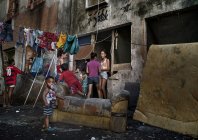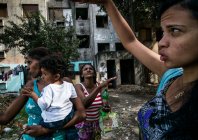
Copacabana Palace, Brazil
Peter Bauza
Echo Photojouurnalism
“Paradise is here, hell is here, madness is here, and passion is here.” The lyrics of Francis Hime’s Sinfonía do Rio de Janeiro de São Sebastião describe the soul and diversity of Rio.
This is the story of people with no roof or land (“sem teto, sem terra”), the story of 300 families who, over the past decade, have been living in dilapidated unfinished buildings in a condominium known to some as Jambalaya (a local TV program), or to others as Copacabana Palace (named after the grand 5‑star hotel on Copacabana Beach).
The background history is that some thirty years ago, a Brazilian construction company built a series of condominiums for middle-class residents in this area 60 km from central Rio de Janeiro. But many of the buildings were abandoned because of problems with both construction and financing, and were left empty for extended periods. Homeless people moved in and have remained, even returning after being evicted.
People here live in extreme poverty, without the basic utilities of water, sanitation and electricity. While Brazil has been spending billions on infrastructure to attract global sporting events such as the 2007 Pan American Games, the 2014 FIFA World Cup, and now the 2016 Olympics, the world has not noticed the grim side of the country. Despite massive anti-poverty policies (mostly for the benefit of the working class), millions of people are still homeless or living in grossly inadequate housing and favelas. The plight of those living “sem teto, sem terra” is hidden away, far from the international media.
Preview






But who are these Copacabana Palace people who are strong enough to resist and persist in such hostile surroundings? Many come from favelas, some have run away from drug dealers, others can no longer pay rent that goes up every month, and some were living on the streets; a number have been granted social housing, but have never been able to move in because of drug gangs and their families controlling the social housing complexes.
Today, the buildings are precarious and dangerous. The environment is always damp, with stagnant water and human waste causing serious health problems such as dengue fever, meningitis, gastroenteritis and skin conditions. In some buildings floors have collapsed, leaving gaping holes.
The people living here have grand dreams, dreams of social housing, of a proper roof. Over the past decade the government has introduced low-interest programs for housing relief, but under certain conditions; there is so much red tape and the waiting time is so long, that the chance of getting housing under the scheme has often been a matter of luck.
This is the story of these people trying to survive, and hoping for a better future. It is the tale of their suffering, of their weaknesses and strengths, failures and successes in their daily efforts to cope and rise above such a hostile situation. The exhibition presents their story and the life I shared with them for seven months. It is a life to be seen, a life with faces and voices.
Peter Bauza






